

 |
||
 |
||
Vol. 7 (2): November 2004 |
Download this page
|
|
Greece / Italy / Madeira / Mauritania & Western Sahara / Morocco / Turkey
Greece
|
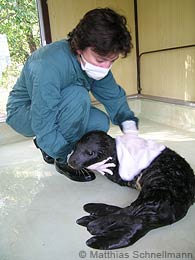 |
|
|
MOm's Jeny Androukaki with Hippocrates in the days following his rescue. |
|
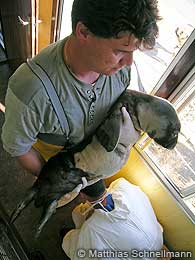 |
|
|
MOm's rehab assistant, Yannis Kyriazis weighs Hippocrates some 30 days after his rescue. |
At 20:00 hrs on Thursday 7 October, a Mediterranean monk seal pup was found stranded on Kefalos beach on the eastern Aegean island of Kos, a popular holiday destination. The discovery was made by local inhabitant Yannis Bezas, who immediately alerted the port police authorities. They, in turn, raised the alarm at MOm’s headquarters in Athens, whose specialists passed on care and surveillance instructions by phone throughout the night.
According to descriptions provided by the port police, the beached orphan appeared anxious, and was unwilling to return to the sea. Despite following standard watch-and-wait instructions, the pup’s mother did not return, making rescue essential.
During the night, local fisherman Sotiris Christodoulou sheltered the orphan at his home, delivering it safely into the hands of MOm’s rescue team – inbound on a flight from Athens – early the following morning.
The assistance provided by the fisherman once again illustrated how human attitudes towards the species – long regarded as a fish-stealing, net-damaging pest – are changing for the better.
The pup was a 2 week old male, weighing 20 kilos. Upon examination, it was found to be dehydrated, with a high temperature and irritated mucosa of the mouth and eyes, leading MOm experts to believe that lactation had been interrupted for more than 24 hours. Superficial wounds were also found on the head and flippers, most likely a result of stormy weather that may have separated the animal from its mother.
First aid and oral rehydration therapy were administered immediately.
With his condition judged critical, the foundling was then quickly transferred by plane to Athens and then on to MOm’s Rescue and Rehabilitation Unit in the National Marine Park of Alonissos-Northern Sporades.
In honour of Kos’ most famous figure from history, and in recognition of the island’s swift action to save its life, the pup was named “Hippocrates”.
Though exhausted after his ordeal, Hippocrates quickly responded to treatment by nursing staff and MOm's consultant veterinarian.
During his first weeks in rehab, the pup was fed on fish porridge; more recently, filleted fish has been added to his diet. Following standard procedure, the aim of the feeding regime will be to build up the seal's body weight to about 50 kilos to prepare him for his release. Orphaned pups in rehab are handicapped by a lack of mother's milk, which is highly nutritious and can be easily assimilated, thereby allowing the animal to gain weight swiftly.
In the complex rehabilitation procedure that may last up to 6 months, MOm is collaborating with the Veterinary School of Thessaloniki and the Virology Department of Erasmus University, Rotterdam.
“Among our political priorities at the same time is the emergence of the protected areas of the country that are part of the Natura 2000 network and to ensure viability of the bodies that undertake their management.”
– Prime Minister Costas Karamanlis, Thessaloniki, 16 July 2004
Although the decision had been predicted as far back as the March elections that swept them to power, it was not until after the internationally-acclaimed Olympics in August that Greece’s new Conservative government took action to reshape the country’s protected area management authorities.
The first step in that process was a Ministry of Interior edict abolishing, in one fell swoop, all of the management authorities established under the previous government’s tenure.
Greece’s protected areas have thus been in a state of limbo for most of the year, with management authorities having neither the funds, nor political backing to pursue even their most basic functions. That also included vital guarding activities during the summer tourist season – the time when infringements and holidaymakers tend to peak.
Legally off-limits to fishing and navigation, the core monk seal refuge of Piperi in the National Marine Park of Alonissos-Northern Sporades (NMPANS) saw increased violations by pleasure boaters during July and August. Similar incidents occurred on the marine turtle nesting beaches of the Marine Park of Zakynthos.
The abolition of the management authorities is seen as a prelude to the government replacing political appointees allied with the previous government with their own candidates. It remains to be seen, however, whether the replacements will be chosen according to merit, experience and management needs – certainly a novel approach compared to the cronyism of the past.
The current debacle has developed despite prime minister Costas Karamanlis’ firm public commitment to the protected areas, expressed during a pre-party congress speech at Thessaloniki on 16 July 2004. During his speech, he stated: “Among our political priorities at the same time is the emergence of the protected areas of the country that are part of the Natura 2000 network and to ensure viability of the bodies that undertake their management.”
The state’s long term financial commitment to the protected areas also remains worrying. As related in our June issue [Doubts confront management authority on Alonissos, TMG 7 (1): June 2004] the government plans to finance the areas through time-limited EU Structural Funds.
Under plans made public by the former government, the management authorities of Greek protected areas would receive just 75% of their funding needs in the first year, 50% in the second, 25% in the third and thereafter, nothing at all. The implication is that the protected areas will then be left to their own devices to raise funds – a sink or swim privatization model that, despite certain merits, also holds considerable risk as management authorities debate the commercial exploitation of the areas under their control while fighting for their own survival.
Without adequate solutions, the long-term viability of the protected areas must remain in serious doubt.
In the meantime, in the government’s abolition of the management authorities effectively means that there are no protected areas in Greece worthy of the name.
Six months after his release into the National Marine Park of Alonissos, Northern Sporades [Clear blue horizon for Dimitris, TMG 7 (1): June 2004], satellite tracking continues to show that Dimitris, the orphaned monk seal, is alive and well.
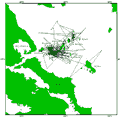 |
|
|
click to enlarge |
In its post-release satellite tracking programme, MOm is working with the Sea Mammal Research Unit of St. Andrews University in Scotland, one of the world’s most experienced institutions in marine mammal satellite tracking.
Data gathered by satellite will undergo systematic analysis and processing once the transmitter is shed naturally with the animal’s first moult.
Initial results, however, already suggest that valuable information will be gained on little understood aspects of monk seal behaviour in the wild, particularly the degree to which individual animals roam between islands and scattered seal groups.
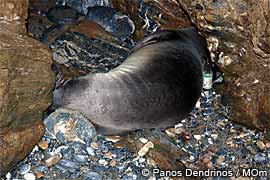 |
|
|
Dimitris cave snoozing in the Sporades Marine Park |
Since his release on 22 May, tracking movements recorded by satellite show that Dimitris has literally combed the expanse of the Marine Park, visiting repeatedly all the inhabited and deserted islands of the Sporades. He has also made it as far as Skyros and Evia.
Particularly impressive have been satellite recordings of Dimitris’ diving activity, showing that he has reached a maximum depth of 180 meters (following an earlier record of 136 meters). The results effectively rewrite current scientific knowledge of the species, which has hitherto held that Mediterranean monk seals can dive up to 70-80 meters.
Beyond the technical means offered by the satellite, firsthand sightings have since confirmed that Dimitris is alive and well — if somewhat thinner than at his release, at the tail end of a fattening-up rehabilitation regime. On 4 August and again one month later, MOm researchers found Dimitris sleeping contentedly in a known monk seal cave in the area.
For further illustrated information on Dimitris’ rescue, rehabilitation and release, check out our News Update Archive page.
With EU backing, Greek and Turkish monk seal conservationists are embarking on the first phase of a project that will help establish a Rescue and Information Network in Turkey.
MOm and SAD-AFAG are collaborating on this venture with the financial support of the Delegation of the European Commission to Turkey, whose Civil Society Development Programme attempts to foster civil dialogue between the two countries, whilst also encouraging best practice transfer of knowledge between experts and NGOs.
MOm’s Rescue and Information Network (RINT) in Greece has been operating for 14 years, and relies on a coastal network of port police officials, fishermen and others to report monk seal strandings, including dead, sick, wounded and orphaned animals. The majority of orphaned seals that have undergone rehabilitation in Greece have been rescued as a result of the operation of the RINT.
Now, as a result of the Commission’s Civil Society Development Programme, MOm and SAD-AFAG will work together on seal rescue and rehabilitation training, and on the establishment of a RINT adapted specifically to Turkey’s coastal needs and characteristics.
 |
|
|
SAD-AFAG's Harun Güçlüsoy with Hippocrates. |
In November, SAD-AFAG’s Harun Güçlüsoy, and the veterinarian of Foça Municipality, Avni Gök, visited MOm’s Seal Treatment and Rehabilitation Centre on Alonissos, in the Northern Sporades Marine Park. Whilst there, the two Turkish visitors experienced firsthand the feeding and intensive care protocols currently being administered to orphaned monk seal pup Hippocrates. Other sessions during the one-week visit, led by the chief of MOm’s rehabilitation division, Jeny Androukaki, and by Stella Adamantopoulou, in overall charge of the organisation’s Rescue and Information Network, were earmarked for discussion on the practical formation of a RINT in Turkey.
The principal aims of the project include:
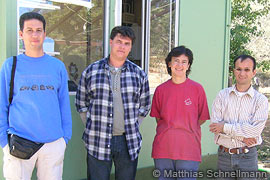 |
|
|
Outside MOm’s Seal Treatment and Rehabilitation Centre on Alonissos (from left to right): SAD-AFAG's Harun Güçlüsoy, MOm's rehabilitation assistant, Yannis Kyriazis, MOm’s rehabilitation division chief Jeny Androukaki and Foça Municipality's veterinarian, Avni Gök. |
“Using similar methodologies and analysis techniques will surely provide better results for the conservation of the species in our common sea, the Aegean,” explained Harun Güçlüsoy, following the information exchange and training sessions on Alonissos.
Veterinarian Avni Gök added: “During our week here we gained valuable experience through the sharing of information and through the practical training we received with Hippocrates. This will be very useful in the event of orphaned pups being found in Turkey.”
Greek experts will travel to Turkey in the next phase of the project, preparing the groundwork for the organisation and launch of the country’s new Rescue and Information Network.
The Monachus Guardian will carry a full report in our next issue.
In January 2005, the EU LIFE-Nature programme “The Mediterranean monk seal: Conservation actions in two Greek NATURA 2000 sites” will be completed. Its aim was the protection of the Mediterranean monk seal through the implementation of specific management actions in two of the species’ most important habitats in Europe: the Karpathos-Saria area in the southeastern Aegean and the Kimolos-Polyaigos complex in the Cyclades [TMG Mediterranean News, passim].
During the four years of the programme, it was possible to gain a comprehensive picture of the status of the Mediterranean monk seal, which verified the significance of these areas for the species. At the same time, pilot conservation actions were implemented, which may be continued by the management bodies when they are established and fully-operational. The value of the natural environment of the areas concerned was also conveyed to locals and visitors. Finally, the active participation of schoolchildren in environmental protection actions probably constitutes the most significant achievement of the programme, as these are the future users of these areas.
In spite of this hard-fought effort, the main requirement for the long-term protection of these areas, namely that they be legally constituted, has yet to be achieved despite prior assurances by the Ministry of Environment, Land Planning and Public Works that this would take place within the time frame of the programme.
Today, five years later, even though the Management Body for Karpathos-Saria has been established, it has no specific object of action, as the area has not been legally constituted, while only a few steps forward have been made with respect to Kimolos, its establishment as a marine park having been delayed indefinitely.
Concluding that the permanent presence of field teams is indispensable to the continuing implementation of management actions in Kimolos and Karpathos, as well as to their promotion as legally constituted protected areas, MOm aims to continue its efforts following the completion of the LIFE programme.
Thus, awareness-raising actions and monitoring of the Mediterranean monk seal population will continue in Kimolos with the support of the PEP programme for the South Aegean, while actions in the area of North Karpathos have been included in the proposals of the Management Body for funding by the Entrepreneurial Programme for the Environment.
Believing that the responsibility for the effective protection and development of these areas lies with all of us, we request that the Ministry of Environment and other responsible ministries, the European Commission and all involved stakeholders, commit whatever support they can to achieve the immediate institution of these areas. – Stella Adamantopoulou, MOm.
 |
|
|
The MOm research boat “IFAW-Odyssia” at Antiparos. |
A highly significant project for the protection of the Mediterranean monk seal has been included in the PEP programme for the South Aegean, which will function between 2004-2006. Entitled “Conservation and promotion of the natural environment in the southwest Cyclades”, the project has educational and research objectives and includes a series of actions on the islands of Antiparos, Folegandros, Sikinos, Sifnos, Serifos, Milos and Kimolos-Polyaigos. The project’s Action Plan includes research to verify the status of the Mediterranean monk seal population in the SW Cyclades as well as ecological awareness-raising activities.
Research priorities also include the monitoring of the monk seal population in the Kimolos-Polyaigos area, which has proven to be one of the most important habitats for the species internationally.
Elsewhere within the project’s geographical limits, MOm researchers have carried out detailed surveys of the coastline of Milos, Antiparos, Sikinos and Folegandros. Thirty-three monk seal caves were identified during the research. The majority of these refuges were identified in Milos, where the presence of a newborn seal was also recorded during the reproduction period. – Panayiotis Dendrinos, MOm.
As part of their 2004 monk seal monitoring programme, MOm researchers gathered data on sea-borne human activities in both Kimolos and Karpathos during the summer months. In Kimolos, tourist activity is particularly high during the peak summer months, with the regular presence of motorized pleasure boats near the reproduction refuges of the Mediterranean monk seal — thus making the adoption of protection measures even more urgent.
In the Karpathos area, it appears that the most intense pressure comes from industrial fishing throughout the year and is a factor to be considered in the institution and future management of the area. – Stella Adamantopoulou, MOm.
As part of MOm’s environmental education activities, the pupils of the Junior High-School of Kimolos, under the guidance of their teacher, Ms. K. Anagnostopoulou, designed an ecotourist guide to the island, with detailed information, photographs and recommended walking paths for nature lovers.
The aim of the guide is to promote the area and to encourage the development of alternative types of tourism by attracting visitors who are personally interested in the protection of the natural environment. The guide was printed with the support of MOm and the European Commission’s LIFE funding mechanism, the Ministry of Environment and the Cyclades Prefectural Authority. Copies were also distributed among the pupils of Kimolos, to enable them to fund an environmental education trip through sales to the local public. – Stella Adamantopoulou, MOm.
The first pups of the 2004-2005 breeding season are being counted by MOm researchers in the National Marine Park of Alonissos-Northern Sporades (NMPANS), at Kimolos-Polyaigos in the Cyclades and at Karpathos-Saria in the southeastern Aegean.
To date, 7 newborn pups have been recorded in the NMPANS, 6 in Karpathos-Saria and 5 in Kimolos-Polyaigos, the latter once again underlying the importance of this island complex as a Mediterranean monk seal breeding site. – Panayiotis Dendrinos, MOm.
Mediterranean News continues with Italy, Madeira, Mauritania & Western Sahara, Morocco and Turkey...
Copyright © 2004 The Monachus Guardian. All Rights Reserved |